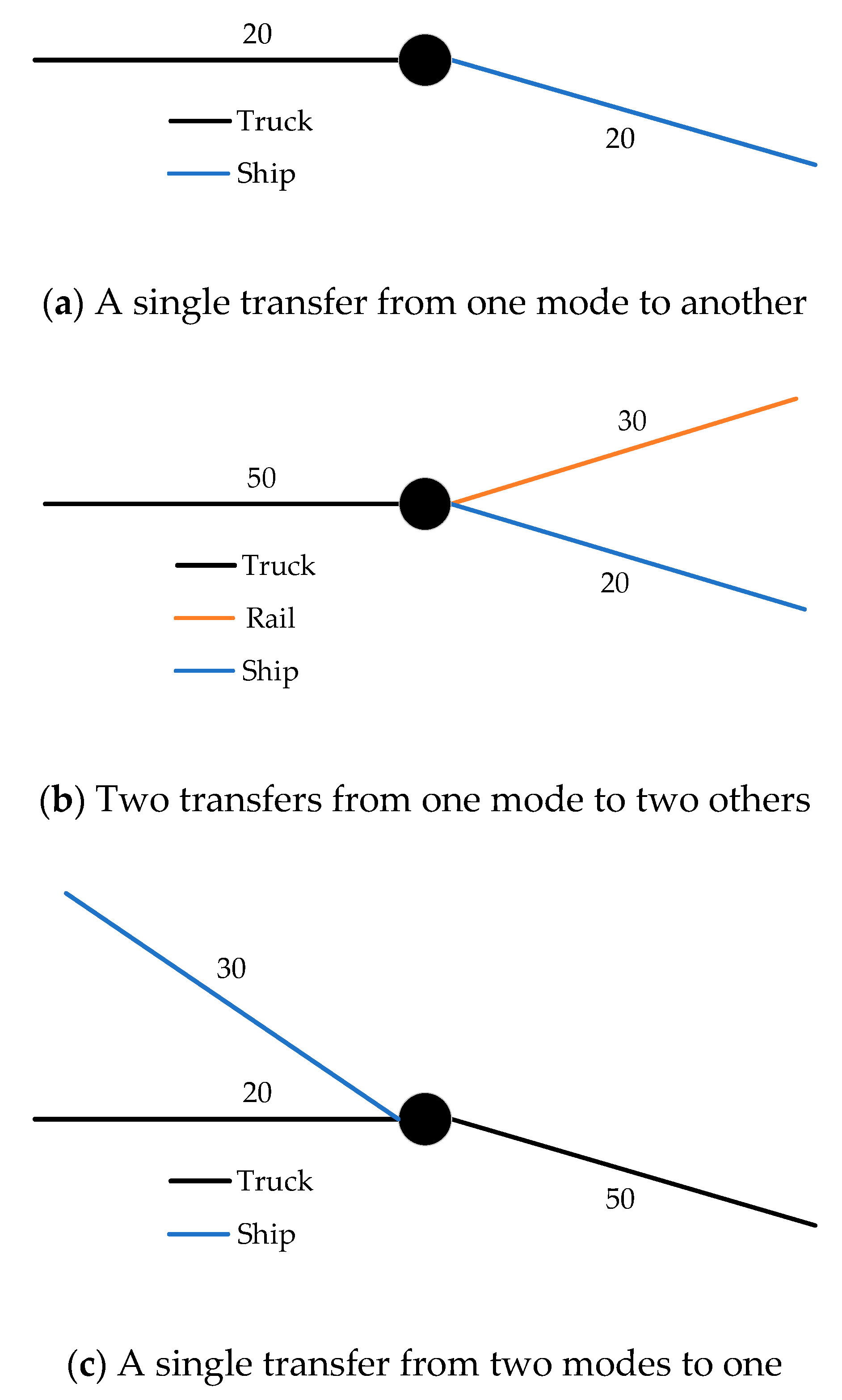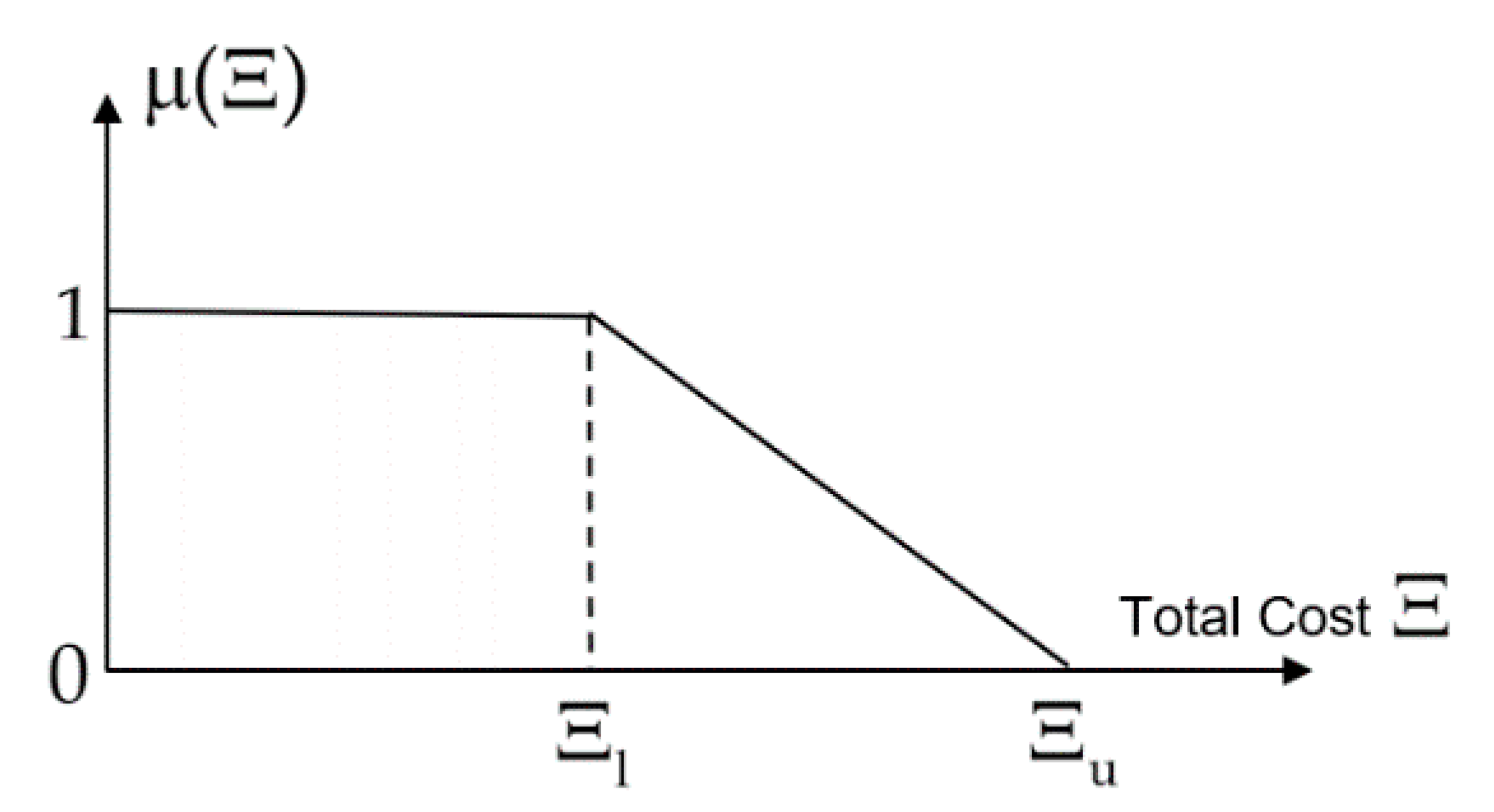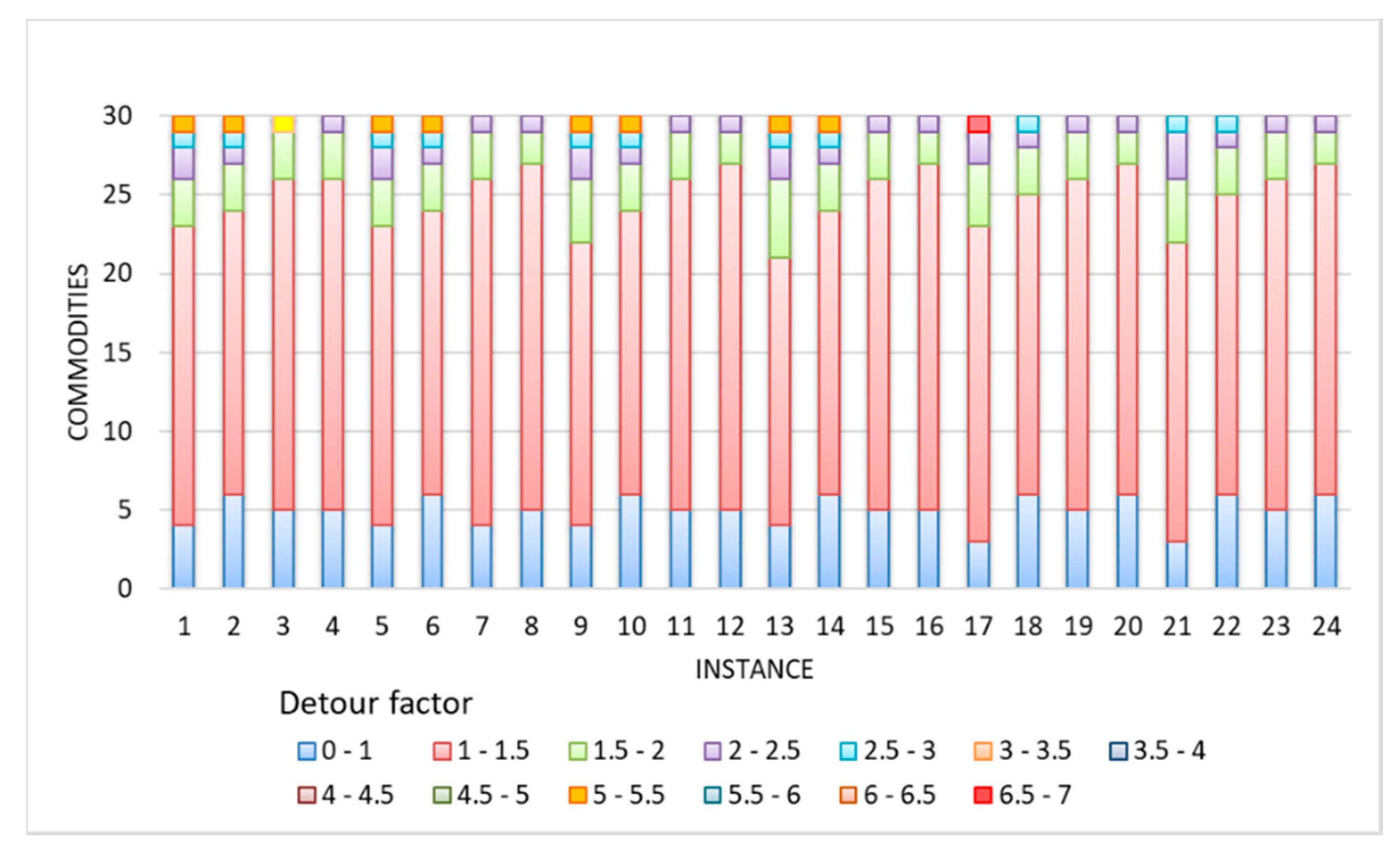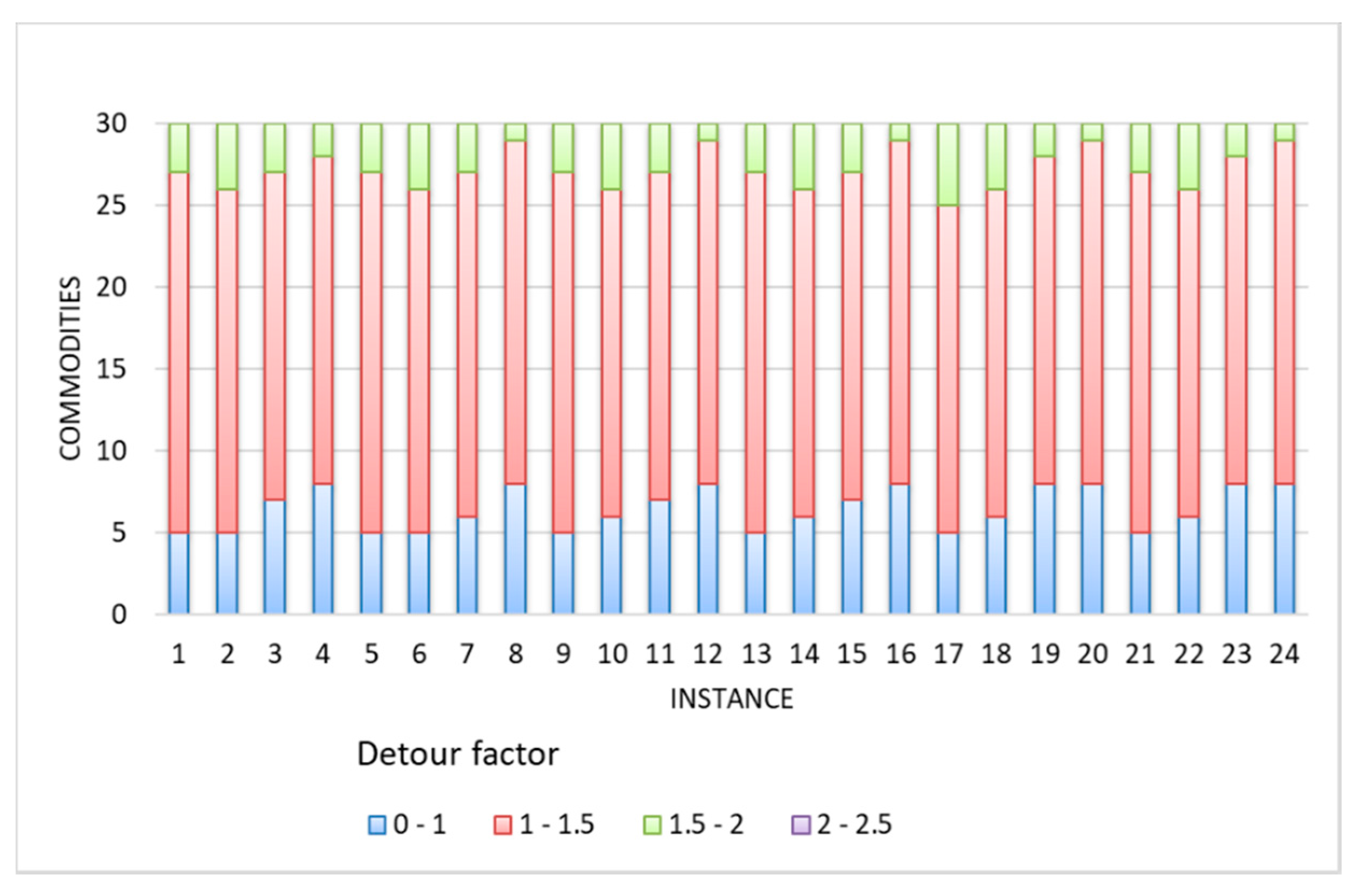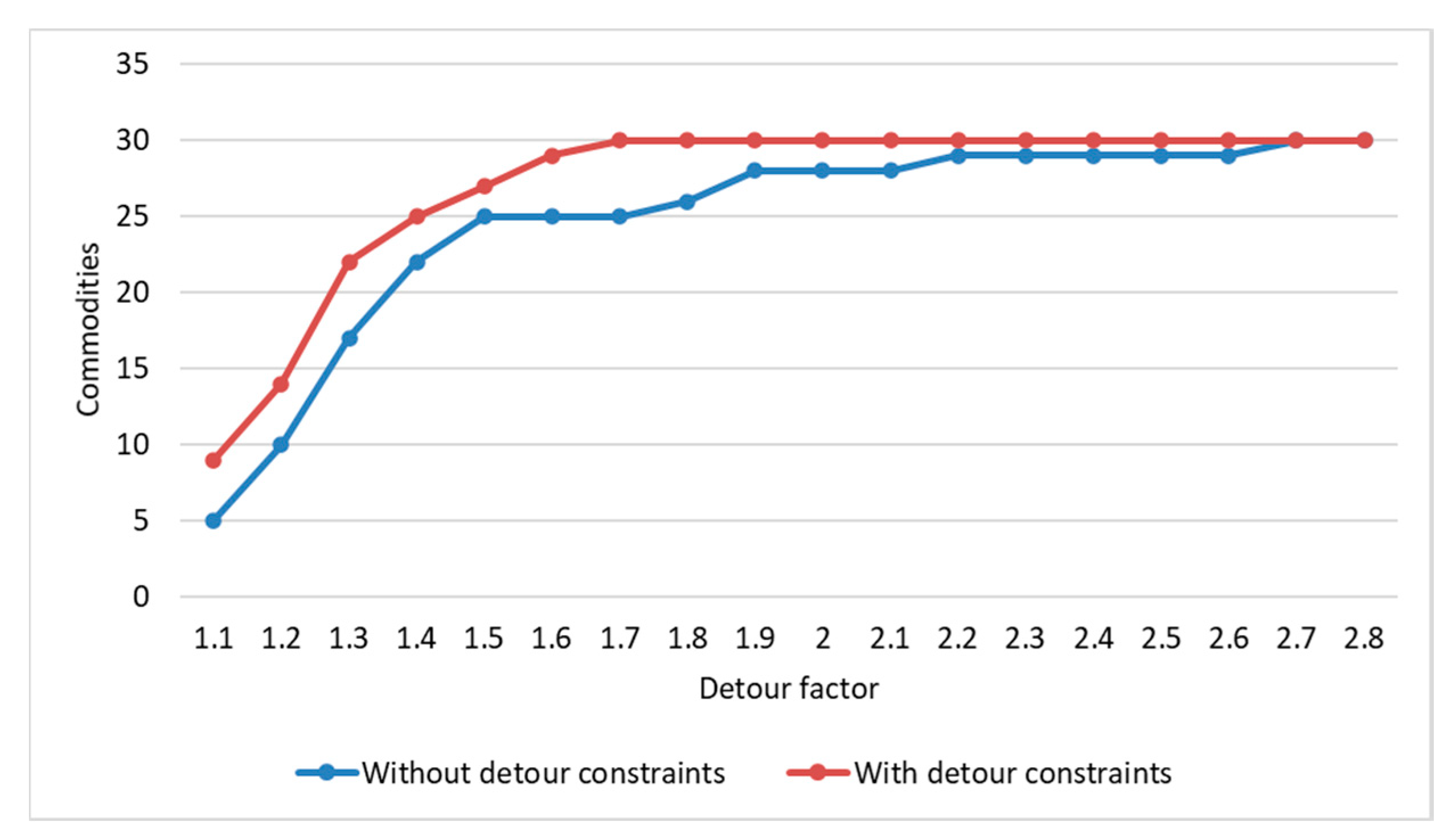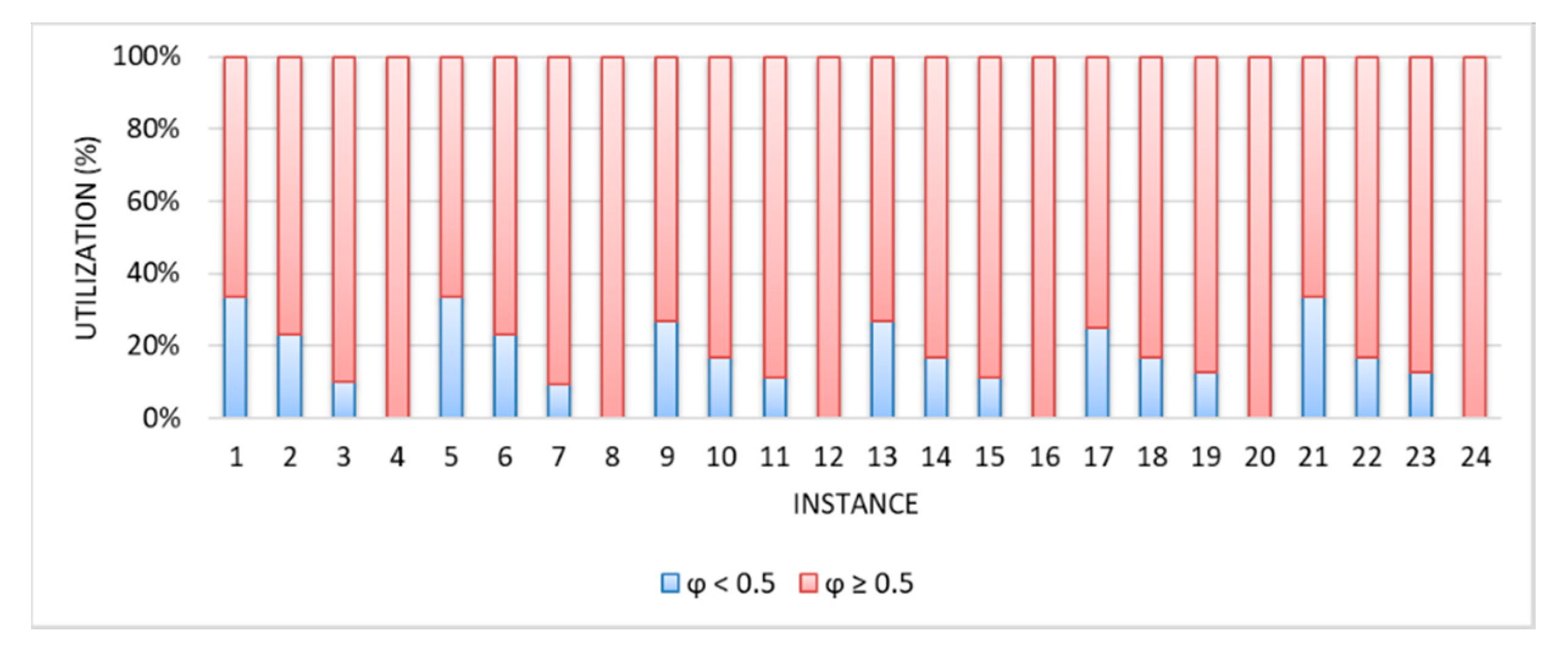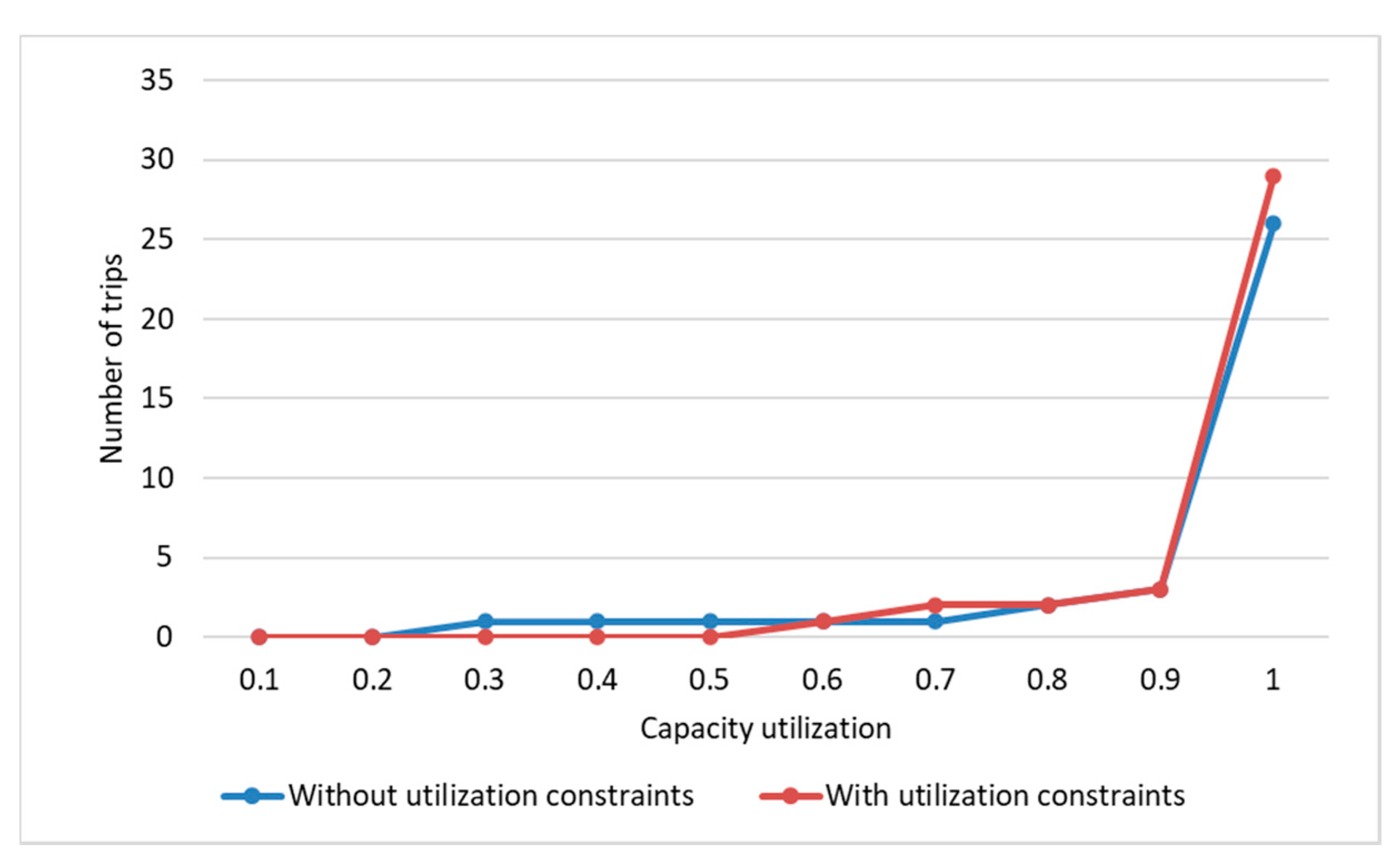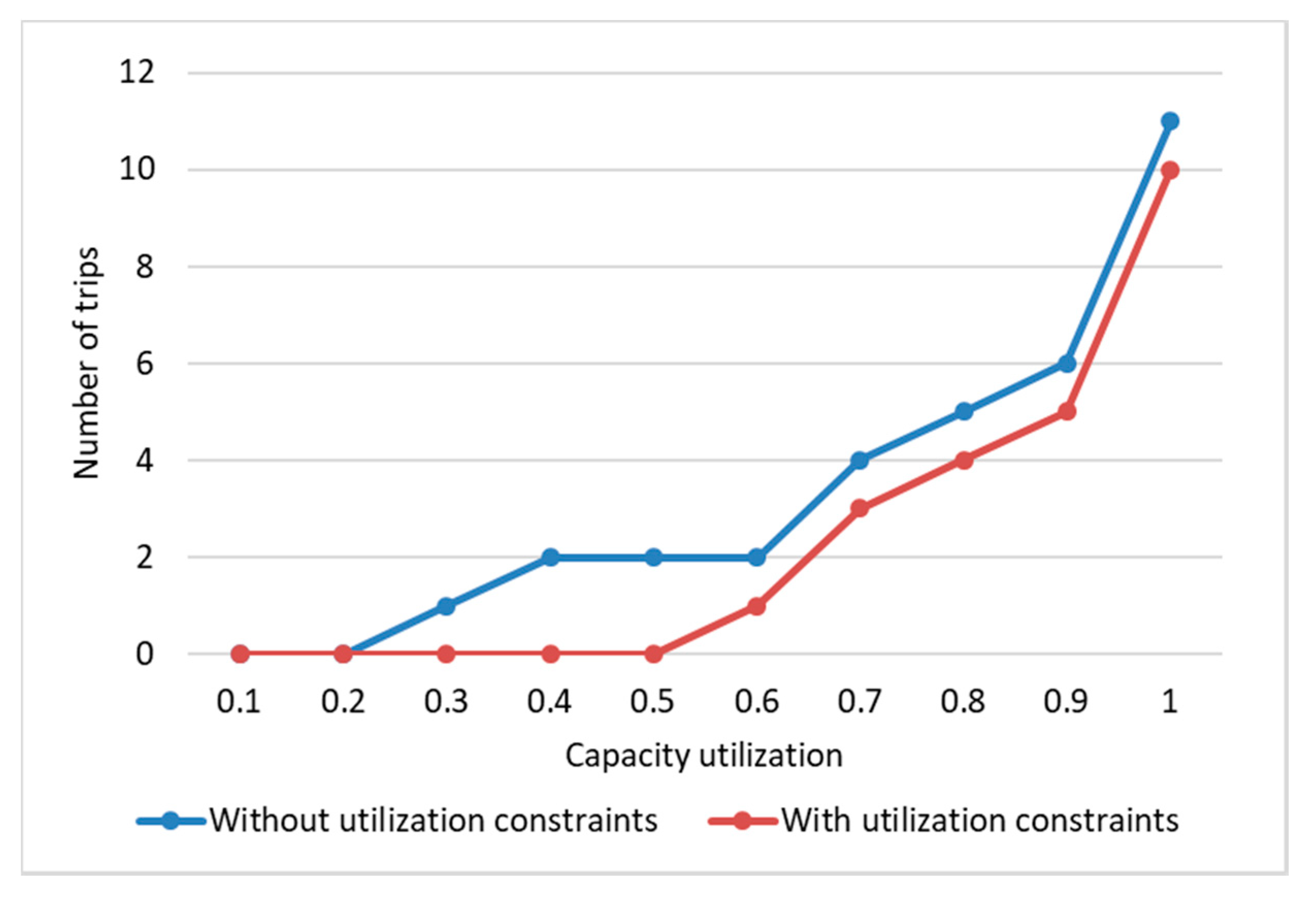1. Introduction
As a result of rapid global economic growth, many countries are being faced with overloaded transport networks. In developed countries, logistics costs account for around 10% of total transport costs, while in developing countries, this figure is 18%. Transport costs typically account for over 50% of overall logistics costs across the entire supply chain. The intermodal transportation system design considers the shipment of goods from their origins to their destinations using several modes of transport. The main characteristic of intermodal transport, and its substantial difference with respect to multimodal transport, is that every part of the process is contracted with a different provider. The transportation industry is rapidly changing as a result of globalization, the development of technology, and population growth. In order to reduce expenses, it is necessary to find faster and cheaper ways to transport freight between locations. However, it is difficult to attain optimal solutions, since multiple objective functions, such as minimization of transportation costs, CO
2 emission costs, intermodal transfer costs, fixed costs, and congestion characteristics, need to be considered [
1].
The main differences among the various modes of transportation include speed, loading and unloading capacity, and cargo safety. These factors contribute significantly to transportation performance, logistics systems, and the supply chain [
2]. Intermodal transportation utilizes various modes of transportation to reduce the disadvantages and maximize the benefit of each model. The many advantages of intermodal transportation include more effective performance, decreased traffic jams, and reductions in the emission of CO
2 to the atmosphere [
3]. Most traditional logistics approaches have focused on reducing total transportation costs by determining the optimal shipment routing in the context of the constraints in the models. This research incorporates the development of intermodal transportation by combining several modes of transport, whereby the transferal of operation between these modes significantly affects overall logistics performance, resulting in additional intermodal transfer costs and CO
2 emission costs with respect to the objective function of global sustainable development [
4].
Terminal congestion usually occurs at terminals, inland container depots, and ports, where the goods are transferred between modes. Terminal congestion is characterized by slow speed and lengthy queuing, which result from the overutilization of infrastructure. Limiting the capability of the equipment can also generate congestion within facilities. Thus, congestion at terminals has a significant impact on transportation decisions, especially terminal allocation and route selection. Congestion resulting from excessive loading at the node, directly and indirectly, leads to inferior performance and additional costs. This study incorporates the capacity constraints at the node in order to limit traffic flows and thus improve operations, in order to provide a higher quality of service to customers [
5,
6].
The transportation routes for moving goods depend on the characteristics of the goods themselves, and the delivery time requirements of the customer, such that frozen and fresh foods are transported rapidly to consumer markets, while other products can be transported more slowly in order to save costs. The detour factor accounts for the additional distance that forms a part of intermodal transportation system performance. Intermodal transportations systems have many terminals at which goods can be transferred from one transportation mode to another. When there is some capacity left in a vehicle, drivers can travel to another terminal to pick up more goods, which may increase the travel distance and transportation time [
7,
8].
Capacity utilization of vehicles is defined in terms of the ratio between the amount that the vehicle is carrying and the maximum amount that the vehicle could carry. The efficient utilization of vehicles is one major factor that helps reduce the number of vehicles required, avoiding terminal congestion, which benefits the carriers. Therefore, the carrier must ensure the effective utilization of the vehicles and maintain a high degree of vehicle utilization [
9].
This paper develops a mathematical model for intermodal freight transportation. The objective function of the model is the minimization of the total cost, which incorporates fixed costs, transportation costs, intermodal transfer costs, and CO2 emission costs. The requirements of stakeholders in the transportation network (port agents, customers, or carriers) are satisfied by different constraints. It is worth noting that this study is the first to simultaneously address node capacity, detour, and vehicle utilization constraints in a mathematical model of intermodal transportation. With respect to node capacity constraints, each node has a capability that limits many of the activities of vehicles, including transfer, sorting/resorting, loading/unloading goods. Node capacity constraints are added to reduce congestion at the considered nodes. Additionally, the delivery time is constrained by detour factors. This allows transfers to take place between modes of transport during their journey, e.g., from roads to inland waterways while ensuring that the weight average network distance of goods does not exceed the additional distance for each type of good, which is within the percentage of the distance (with the shortest path) over the network. Finally, the vehicle utilization constraints define the minimal desired utilization of used vehicles. These constraints require the capacity usage of vehicles to be at least 50%, thereby helping reduce the number of vehicles, avoiding terminal congestion, and ensuring the effective operation of carriers in the utilization of their vehicles.
The managerial implications of this paper can be clarified as follows. Carriers, customers, and cargo owners are expected to be beneficiaries of the node capacity constraint as a result of reducing terminal congestion during peak hours at the terminal and improving the delivery time of the goods. Facility operators, third-party logistics, and carriers are expected to be beneficiaries of the detour and vehicle utilization constraints due to the improvements in fuel costs, cargo safety, and logistics costs, to name a few. The Southern Vietnamese transportation system is used as a case study to illustrate how to apply the model in practice. There are two types of vehicles—trucks (road transport) and ships (inland waterways)—considered in this model. The main objective of this paper was to build a mathematical model and determine the transportation routes for all goods from their origins to their destinations across the network in such a way that good logistical performance is indicated. Furthermore, in terms of global sustainable development goals related to environmental problems, intermodal transfer costs and CO2 emission costs are crucial indicators to be measured and handled, accordingly.
The contributions of this paper are three-fold. First, the paper presents a mixed integer linear programming (MILP) model formulation that captures the common characteristics of the intermodal freight transportation, while other important aspects, including node capacity, detour, and vehicle utilization, are incorporated in order to estimate the performance impacts. Second, fuzziness in important node capacity is considered in a fuzzy mixed integer linear programming (FMILP) model in order to investigate the impacts of node capacity uncertainty. Finally, an analysis is conducted to compare different vehicle capacities and detour factors under various scenarios for both deterministic and fuzzy cases. These results can act as a useful reference for the Vietnamese government, logistics stakeholders, and international investors for the purpose of investing, designing, and improving logistics systems and appropriate strategies for achieving government goals toward global sustainability. Additionally, this could be utilized as a reference for other purposes.
This paper is divided into five sections. The first section gives an overview of the research background, a logical guide, the key points, and the overall objective of the research. The second section describes previous papers that are relevant with respect to intermodal transportation. The mathematical models, MILP and FMILP, are built and described in the third section. The fourth section presents a computational experiment to analyze the results of these two models under a variety of scenarios, and the last section presents a summary of all of the findings of this paper, along with ideas for some potential future research.
2. Literature Review
There have been many relevant studies about the multimodal transportation model in the past few decades. With intermodal systems, the contractors can save up to 18% of the truckload that amounts to a considerable monetary value. Intermodal transport, the incorporation, and combination of several modes for single or multi-goods, toward the sustainability, environmentally friendly, and ecological aspect of the green logistics systems, compared to the unimodal of transportation, meaning that the transport model only uses one mode such as rails or roads [
10]. Logistics costs in Vietnam are still higher than the association of southeast Asian Nations (ASEAN) average, which has decreased its eligibility to participate in the global value chain. These costs reflected the inefficient logistics system of the country, which consist of logistics costs, logistics services, and logistics infrastructures [
11]. This paper studies the problem in the intermodal transportation systems in Southern Vietnam, where road transport and inland waterways are the popular transportation modes. The purpose of solving the case study is to provide a general view of the transportation network in Southern Vietnam and offer insights into the status of the logistics systems of the country.
In this section, the benefits of intermodal transportation through previous studies are reviewed. Tahvanainen et al. [
12] suggested the scenarios for shipping energy wood. The results showed that using truck mode was the optimal choice for a distance of less than 60 km. From 60 to 135 km, roadside chipping was the most efficient cost. From 135 to 165 km, the train was a more suitable selection with minimizing transport costs, depending on the fuel sources. As well, the optimal solution was the combination of roadside chipping, truck mode to the node, and train mode to the factory (intermodal freight transportation). Wiegmans et al. [
13] built a model to compare the efficiency between road-only-mode and the intermodal inland waterways and roads. The results considerably improved the competitiveness of the transportation mode using inland waterways. Frémont et al. [
14] showed results of combining road transport with other modes of transport (rails, waterways) could reduce transportation costs by around 10–20%. Concerning environmental effects, Craig et al. [
15] evaluated the impacts of CO
2 emissions to the atmosphere using intermodal freight transportation. The results showed that intermodal freight transportation reduced about 50% of the amount of CO
2 emissions compared to truckload mode.
There have been many investigations on the design of the intermodal transportation system approaches, which consist of determining the transport routing and node locations for saving the transportation costs and lowering CO
2 emissions of the environment. Limbourg et al. [
16] used the p-hub median method to find the optimal coordinate for the European transport agency. Arnold et al. [
17] proposed a mathematical model for the rail/road transportation system aiming to find the best allocation for a case study in the Iberian Peninsula. In addition, Van Duin et al. [
18] studied the problem of hub location determination. The results are simulated to demonstrate the effectiveness of the model. Chang [
19] proposed a mathematical model with an algorithm to solve the intermodal transportation under three problem characteristics, which are multi-objective multi-goods and multi-modal, schedule delivery time and terminal, and the economics of scale. Some mathematical programming approaches for the intermodal transport network were also presented through other previous studies. The framework of models for transport network design considered: (1) the transport systems design, (2) passageway, (3) hub logistics, (4) connected hubs, (5) direct transport routing, (6) indirect transport routing, and (7) dynamic transport routing [
20,
21,
22,
23,
24].
Stochastic factors were considered in intermodal transportation, which are demand, node capacity, or transportation costs. Zadeh [
25] presented the fuzzy set approach, and then it was applied to many research areas. For transportation network design, Bit et al. [
26] proposed modeling of fuzzy linear programming in order to solve the intermodal transportation with multi-objective. Furthermore, Verma et al. [
27] presented a model of non-linear membership functions to solve multi-objective transportation. Findings were compared to those obtained from the linear membership function. Ebrahimnejad [
28] displayed the stochastics transportation network by the ranking concept of the fuzzy numbers. The main contribution of this research was to reduce the computational complexity of the previous approaches.
The node capacity has a high correlation to the terminal congestion at the transport node. At the node of intermodal, there are some activities of vehicles such as transferring, sorting/resorting, loading/unloading goods. Hence, node capacity and congestion significantly affect intermodal transportation performance. Capacity constraints were considered in previous studies. Rodríguez et al. [
29] proposed an annealing algorithm to solve the hub location, which was considered capacity constraints. This paper also proposed a balanced module to reduce terminal congestion. Moreover, Elhedhli et al. [
30] applied a Lagrangian heuristic to solve the problem of hub location with the constraint of traffic jams.
Detour factor was defined by the ratio between the length of additional distance and shortest paths from origins to destinations. The intermodal transportation system design considers changing transportation mode at a terminal. Hence, the detour factor is for shifting to a suitable transport for shipping goods [
31]. There have been some related studies as follows. Ballou et al. [
7] showed that the detour factor varies due to road network density, travel obstacles, and natural obstacles. Üster et al. [
32] proposed a tabu search framework to consider tour length constraints for multi-zone truckload shipments. Moreover, Üster et al. [
33] developed an efficient Bender’s decomposition-based approach to handle the large-size instances problems. This study considered driver tour lengths, load imbalance at relay points, the percentage circuity constraints, and provided a strategic design in truckload transportation.
Vehicle capacity utilization also is a factor that affects the performance of intermodal transportation. Sarkar et al. [
34] proposed the mathematical formulation for determining the subset of suppliers in order to maximize the vehicle capacity utilization, as well as reduce the costs and delivery time. However, vehicle capacity utilization is based on customer demand, product characteristics, and schedule plans [
35]. The vehicle utilization has been considered in several previous pieces of research as follows. McKinnon et al. [
9] described the causes that affect trucks’ capacity utilization in transportation systems, which are the segment market, government regulation, logistics infrastructure, and packaging and handling equipment. For maritime transportation, Styhre [
36] suggested that the vehicle capacity utilization is affected by routing characteristics (trade inequalities, demand fluctuation, competing locations, markets, customers, and cargo types). Maraš et al. [
37] studied the utilization of the barge container. The results showed that 88% is the level to maximize the value of a freighting corporation. In addition, Gelareh et al. [
38] demonstrated that the profit for the company was affected by 50–90% of the vessel capacity. Concerning vehicle routing problems, Goetschalckx et al. [
39] proposed a two-phased solution methodology for reducing the number of trucks ordered and improving their capacity utilization. Kim et al. [
40] studied the vehicle capacity in reverse logistics. The authors introduced vehicle routing methods to minimize transportation distance with a case study in South Korea.
This paper aims at filling some significant research gaps in the scope of intermodal transportation under study. To the best of our knowledge, this research is the first to solve node capacity, detour, and vehicle utilization constraints simultaneously in the mathematical model of intermodal transportation problems. The MILP model is formulated with the objective to minimize the total cost that includes fixed costs, transportation costs, intermodal transfer costs, and CO2 emission costs. The constraints representing the node capacity, detour, and vehicle utilization are incorporated to estimate the performance impacts under computational experiments. Moreover, the FMILP model is formulated for the problem to analyze the effects of node capacity fluctuation on the results. The case study is presented to demonstrate the operational performance of the intermodal system that combines roads and inland waterways in Southern Vietnam. The results can provide to the Vietnam government, logistics stakeholders, and international investors, a useful guideline to design and improve the logistics systems and some proper strategies for reaching the goals of the economy and many related fields. In addition, node capacity constraints help provide information about congested terminals for stakeholders, e.g., cargo owners, to push their goods to be shipped through more efficient routes and to address traffic congestion problems.
5. Discussions and Conclusions
In this paper, a mixed integer linear programming (MILP) model and a fuzzy mixed integer linear programming (FMILP) model for intermodal transportation systems have been developed for shipping goods from origins to destinations. The MILP model minimizes the total costs of fixed costs, transportation costs, intermodal transfer costs, and CO2 emission costs. Other requirements of network stakeholders such as port agents, consumers, and carriers are considered with the constraints of node capacity, detour factor, and vehicle utilization. A Southern Vietnam transportation system that considers 15 nodes and 30 different main types of goods, is used as a case study to illustrate how to apply the model in practice. There are two types of vehicles, trucks (roads) and ships (inland waterways), which are considered in this case study. From the results, if the restrictions were not considered in the model, the network may have some overused terminal that encounters heavy load. Goods must be delivered much longer than usual, causing delays in deliveries (large detour level) and vehicles cannot be used effectively. By adding the constraints, the problem can now be better handled while increasing the total cost by 20%. The FMILP model considers uncertainty in the node capacity to investigate the impacts of uncertainty. The robust solution shows that the total cost of the FMILP model is increased by 4% in comparison to the total cost of the MILP model.
In summary, our contributions include (1) theoretical contributions, the paper proposed the MILP model that captures the common characteristics of the intermodal freight transportation as well as other important aspects, including node capacity, detour, and vehicle utilization, incorporated to estimate the performance impacts and the FMILP model to investigate impacts of node capacity uncertainty; (2) managerial implications, the case study in Southern Vietnam is presented to demonstrate the operational performance of the intermodal system that combines roads and inland waterways. The findings will provide a helpful reference for the government of Vietnam, logistics stakeholders, and foreign investors to design and enhance logistics systems and some suitable strategies to achieve the objectives of the economy and many related fields. Additionally, node capacity constraints help to provide stakeholders, such as cargo owners, with knowledge about congested terminals to force their goods to be transported along more productive routes. This can also be a useful guideline for the Ministry of Transport of Vietnam to address traffic congestion problems, which are taking place constantly and seriously in Vietnam for decades. It is also worth noting that the solution was found to solve not only economic problems but also addressing environmental issues that cannot be ignored in the current global situation by considering additional intermodal transfer costs and CO2 emission costs in the objective function.
Nevertheless, there are some limitations to this study. First, only two modes of transport, roads and inland waterways, were considered. Second, the number of nodes was insignificant. Finally, fluctuation in the related costs was not considered in the model. Further research should aim to address large-scale problems with more transportation modes, more nodes, and include uncertain (fuzzy) cost coefficients, and/or demand. In addition, the effect of terminal congestion can be incorporated into the objective of the model. In addition, the model can be applied to another region of Vietnam with adjusted data.
